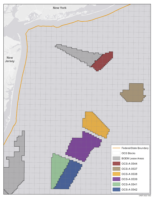The U.S. Dept. of Energy seeks proposals for both demonstration and large-scale projects that use “transformational” carbon capture technologies in the power and industrial sectors, DOE announced Feb. 23. The agency plans to spend up to $2.5 billion across two new programs established by the federal infrastructure law enacted in 2021.
Carbon capture and storage (CCS) or carbon capture, utilization and storage (CCUS) projects have had a complicated past, with some notable failures caused by runaway cost overruns, along with successes, such as Shell Canada’s C$1.3 billion Quest CCUS project in Fort Saskatchewan, Alberta, one of the first and largest successfully operating carbon capture power projects in the world.
In a study of DOE CCS demonstration projects released in 2021, the U.S. Government Accountability Office called for more program oversight after several failed attempts to demonstrate funded technologies and accelerate commercial deployment. GAO said the agency spent about $1.1 billion since 2009 to demonstrate 11 large-scale projects at coal-fired power plants and industrial facilities but demonstrations ended with just three of 11 projects being built.
DOE says the new programs have been set up to spur investment of private capital on CCUS projects by “de-risking” the use of emerging and transformational carbon management technologies.
The Carbon Capture Large-Scale Pilots program will award up to $820 million for up to 10 projects that demonstrate promising technologies at commercial scale in both the power and industrial sectors.
The Carbon Capture Demonstration Projects program will award up to $1.7 billion for about six projects to demonstrate commercial-scale carbon capture technologies integrated with CO2 transportation and geological storage infrastructure. Two of the six must be for new or existing industrial facilities not related to electricity generation.
"This program focuses on funding demonstration projects that can be readily replicated and deployed at power plants and major industrial sources of carbon emissions, such as cement, pulp and paper, iron and steel,” DOE said in its funding announcement.
“There is somewhat of a chicken and egg challenge with large commercial scale CCUS projects. The costs/economics of the projects have been a challenge for them to move forward, but at the same time the absence of large-scale commercial plants can also hinder the continued technical and economic development and advancement that allows for further implementation," says Justin Schnegelberger, Burns & McDonnell energy group manager of development engineering. "This phenomenon is exactly what the federal funding is intended to address.”
Some technologies have existed for years and evolved over time, but there are newer promising technologies as well. Both could benefit from the DOE funding, he says.
Curt Graham, vice president of technology at Fluor Corp., describes the Inflation Reduction Act’s boost in the 45Q tax credit for carbon capture projects—from $50 per ton of captured CO2 to $85 per ton—as a game-changer. The credit, coupled with the infrastructure law funding, will help more commercial-scale carbon management projects come online, he says.
“We are definitely seeing a big upturn in funding inquiries and study requests,” Graham adds. DOE grants "around front-ends of projects and even some construction and implementation are fantastic, but I think 45Q has fundamentally changed the revenue situation and return on investment. I think these are economical projects now.”
Doug Cowin, Burns & McDonnell CCUS/environmental services business development manager, says that one hurdle that prevents some CCUS projects from moving forward is the lengthy process for Class VI CO2 injection well permits. This process “continues to slow the startup schedule for many—if not most—CCUS projects,” he says.
Fluor’s Graham adds that the permitting process varies from jurisdiction to jurisdiction, depending on whether one is already set up to issue necessary permits. “I don’t believe that there are a lot of technical questions around the ability to sequester, it’s more [related to whether] permitting regimes are in place," Graham says. "If you have to come up with a regime when the project is trying to permit, it takes a long time.”
Concept papers for the pilot projects are due April 5; letters of intent for the demonstration projects program are due March 28.






Post a comment to this article
Report Abusive Comment